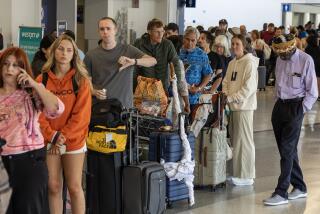Tuberculosis cases fall in L.A. County, state
Public health officials announced Thursday that tuberculosis cases in the state had dropped to historic lows last year, but they also expressed concern over small increases in 20 counties.
State officials reported 2,781 new tuberculosis cases -- a nearly 50% drop from the state’s peak in 1992.
Los Angeles County, which accounts for a third of the cases in the state, continued its downward trend, reporting 933 cases last year.
The 20 counties reporting increases covered a mix of urban and rural areas, including Merced, San Joaquin, San Diego, San Mateo and Tulare counties. In most of the counties, the increase over the previous year was fewer than 10 cases.
Santa Clara County saw the largest increase, from 199 cases in 2005 to 228 last year.
“We’re worried,” said Dr. Sundari Mase, the county’s tuberculosis controller. “I’m not sure this necessarily marks a trend that is going to continue, but we need to redouble our efforts.”
The increases were modest, but they were worrisome given the declining number of cases in California and the U.S.
The federal Centers for Disease Control and Prevention reported national figures on tuberculosis Thursday, saying that new cases of the disease had fallen to 13,767 -- the smallest number since recordkeeping began in 1953.
The World Health Organization also reported its global tuberculosis figures Thursday, saying that while the number of cases continues to rise, the rate of new infections for the first time in modern memory was “on the threshold of decline.”
Tuberculosis is an often-lethal infection of the lungs characterized by fever, weight loss, night sweats and coughing up of blood.
Mycobacterium tuberculosis, the microorganism that causes the disease, spreads in microscopic droplets released when an infected person coughs, sneezes or speaks. Infection occurs primarily through prolonged close contact. Once a person is infected, the bacterium can lie dormant for days or years. It can be treated with antibiotics. Most patients must take them for at least six months.
State and county health officials were uncertain why some counties saw an increase in cases, but they said that population growth, immigration and normal variations in disease transmission all played a role.
About three-quarters of tuberculosis cases in the state involved foreign-born residents.
“Tuberculosis transmission occurs even in the best of circumstances,” said Dr. Jennifer Flood, chief of tuberculosis epidemiology and surveillance at the California Department of Health Services. “We’ve worked hard to control TB and have targeted elimination.”
Among the most worrisome recent developments has been the rise of drug-resistant forms of tuberculosis, caused by patients who didn’t finish a full course of antibiotic treatments.
The most serious form is known as extensively drug-resistant tuberculosis. This strain can make patients infectious for much longer and is much more difficult to treat, Flood said. The fatality rate for this form of the disease is six times higher than regular tuberculosis, according to the Centers for Disease Control and Prevention.
The center has recorded 49 cases in the U.S. since 1993. California health officials have seen 15 cases of extensively drug-resistant tuberculosis in that time. Eight of the patients were from Los Angeles County.
“We’re the biggest county, so that would not be entirely surprising,” said Dr. Jonathan E. Fielding, Los Angeles County’s public health director. “But it’s obviously concerning when you have a disease which is very, very difficult to cure.”
The remaining cases were in Orange, San Francisco, San Joaquin and Solano counties.
*
*
(BEGIN TEXT OF INFOBOX)
Mixed results
Tuberculosis cases statewide dropped to their lowest point since record keeping began in 1985. But from 2005 to 2006, there were more cases in 20 counties. Here’s the statewide trend since 1997:
*--* Counties with increases 2005 2006 Colusa 0 2 El Dorado 4 5 Glenn 0 1 Imperial 32 33 Lake 0 1 Mendocino 2 4 Merced 8 9 Napa 3 7 Placer 5 6 Riverside 60 74 San Benito 0 1 San Diego 305 315 San Joaquin 63 78 San Mateo 62 78 Santa Clara 199 228 Sonoma 11 14 Stanislaus 11 16 Sutter 1 3 Trinity 0 1 Tulare 15 21
*--*
*
Source: California Department of Health Services






